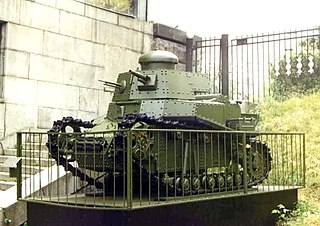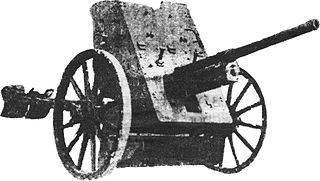
The T-34 is a Soviet medium tank introduced in 1940. Its 76.2 mm (3 in) tank gun was more powerful than its contemporaries while its 60 degree sloped armour provided good protection against anti-tank weapons. The Christie suspension was inherited from the design of American J. Walter Christie's M1928 tank, versions of which were sold turret-less to the Red Army and documented as "farm tractors", after being rejected by the U.S. Army. The T-34 had a profound effect on the conflict on the Eastern Front in the Second World War, and had a lasting impact on tank design. After the Germans encountered the tank in 1941 during Operation Barbarossa, German general Paul Ludwig Ewald von Kleist called it "the finest tank in the world" and Heinz Guderian affirmed the T-34's "vast superiority" over German tanks. Alfred Jodl, chief of operations staff of the German armed forces noted in his war diary "the surprise at this new and thus unknown wunder-armament being unleashed against the German assault divisions," although its armour and armament were surpassed later in the war.

The IS tanks were a series of heavy tanks developed as a successor to the KV-series by the Soviet Union during World War II. The IS acronym is the anglicized initialism of Joseph Stalin. The heavy tanks were designed as a response to the capture of a German Tiger I in 1943. They were mainly designed as breakthrough tanks, firing a heavy high-explosive shell that was useful against entrenchments and bunkers. The IS-2 went into service in April 1944 and was used as a spearhead by the Red Army in the final stage of the Battle of Berlin. The IS-3 served on the Chinese-Soviet border, the Hungarian Revolution, the Prague Spring and on both sides of the Six-Day War. The series eventually culminated in the T-10 heavy tank.

The T-26 tank was a Soviet light tank used during many conflicts of the Interwar period and in World War II. It was a development of the British Vickers 6-Ton tank and was one of the most successful tank designs of the 1930s until its light armour became vulnerable to newer anti-tank guns. It was produced in greater numbers than any other tank of the period, with more than 11,000 units manufactured. During the 1930s, the USSR developed 53 variants of the T-26, including flame-throwing tanks, combat engineer vehicles, remotely controlled tanks, self-propelled guns, artillery tractors, and armoured carriers. Twenty-three of these were series-produced, others were experimental models.

The T-35 was a Soviet multi-turreted heavy tank of the interwar period and early Second World War that saw limited production and service with the Red Army. Often called a land battleship, it was the only five-turreted heavy tank in the world to reach production, but proved to be slow and mechanically unreliable. Most of the T-35 tanks still operational at the time of Operation Barbarossa were lost due to mechanical failure rather than enemy action. It was designed to complement the contemporary T-28 medium tank; however, very few were built.

The BT tanks were a series of Soviet light tanks produced in large numbers between 1932 and 1941. They were lightly armoured, but reasonably well-armed for their time, and had the best mobility of all contemporary tanks. The BT tanks were known by the nickname Betka from the acronym, or its diminutive Betushka. The successor of the BT tanks was the famous T-34 medium tank, introduced in 1940, which would replace all of the Soviet fast tanks, infantry tanks, and medium tanks in service.

The SU-152 is a Soviet self-propelled heavy howitzer used during World War II.

The ISU-122 was a Soviet assault gun used during World War II, mostly in the anti-tank role.

The T-24 was a Soviet medium tank built in 1931. Only twenty four were built, and none saw combat. This was the first tank produced at the KhPZ factory in Kharkov, which was later responsible for the very successful BT series, T-34 and T-54 Soviet tanks. The T-24's suspension was used successfully in the Soviet Union's first purpose-built artillery tractors.

The T-50 was a light infantry tank built by the Soviet Union at the beginning of World War II. The design for this vehicle had some advanced features, but was complicated and expensive, and only a short production run of 69 tanks was completed.

The 152 mm howitzer-gun M1937 (ML-20), is a Soviet heavy gun-howitzer. The gun was developed by the design bureau of the plant no 172, headed by F. F. Petrov, as a deep upgrade of the 152-mm gun M1910/34, in turn based on the 152-mm siege gun M1910, a pre-World War I design by Schneider. It was in production from 1937 to 1946. The ML-20 saw action in World War II, mainly as a corps / army level artillery piece of the Soviet Army. Captured guns were employed by Wehrmacht and the Finnish Army. Post World War II, the ML-20 saw combat in numerous conflicts during the mid to late twentieth century.

The D-1 howitzer M1943 is a Soviet World War II-era 152.4 mm howitzer. The gun was developed by the design bureau headed by F. F. Petrov in 1942 and 1943, based on the carriage of the 122 mm howitzer M1938 (M-30) and using the barrel of the 152 mm howitzer M1938 (M-10). The powerful and mobile D-1, with its wide range of ammunition, significantly increased the firepower and breakthrough abilities of Red Army tank and motor rifle formations. Several hundred D-1s were manufactured before the end of World War II.

The 76-mm divisional gun M1936 (F-22) was a Soviet divisional semi-universal gun, adopted for Red Army service in 1936. This gun was used in conflicts between the USSR and Japan on the Far East, in the Winter War and in World War II. Many F-22s were captured by the Wehrmacht, modernized by the Germans and used against Soviet forces.

The T-18 light tank was the first Soviet-designed tank. Produced from 1928 to 1931, it was based on the Renault FT, with the addition of a vertically sprung suspension.

37 mm anti-tank gun model 1930 (1-K) was a Soviet light anti-tank gun used in the first stage of the German-Soviet War.

A super-heavy tank or super heavy tank is any tank that is notably beyond the standard of the class heavy tank in either size or weight relative to contemporary vehicles.

152 mm mortar M1931 (NM) was a 152.4 mm (6 inch) artillery piece originally developed by the German arms manufacturer Rheinmetall. The gun was produced in limited numbers in the Soviet Union and saw action with the Soviet Army in World War II. A modified version of the design was also adopted in Germany, as 15 cm sIG 33.
The T-19 was a Soviet light tank design of the interwar years. Conceived as the mainstay of the new Soviet tank armies, it was a development of the T-18, ultimately based on the First World War-era French Renault FT. When ready for production in 1931, it was already obsolete; the project was terminated in favour of the Vickers based T-26.

ZSU-37 was a Soviet-made, light, self-propelled anti-aircraft gun (SPAAG), developed by the end of 1943 and produced at Works No. 40 in Mytishchi. It was the first Soviet series-produced tracked SPAAG. ZSU stands for Zenitnaya Samokhodnaya Ustanovka, meaning "anti-aircraft self-propelled mount".

More than 50 different modifications and experimental vehicles based on the T-26 light infantry tank chassis were developed in the USSR in the 1930s, with 23 modifications going into series production. The majority were armoured combat vehicles: flame tanks, artillery tractors, radio-controlled tanks (teletanks), military engineering vehicles, self-propelled guns and armoured personnel carriers. They were developed at the Leningrad Factory of Experimental Mechanical Engineering by talented Soviet engineers P.N. Syachentov, S.A. Ginzburg, L.S. Troyanov, N.V. Tseits, B.A. Andryhevich, M.P. Zigel and others. Many Soviet tank engineers were declared "enemies of the nation" and repressed during Stalin's Great Purge from the middle of the 1930s. As a result, work on self-propelled guns and armoured carriers ceased in the USSR during that time. T-26 light tanks were also modified into armoured combat vehicles in the field during wartime.
This article deals with the history and development of tanks of the Soviet Union and its successor state Russian Federation from their first use after World War I, into the interwar period, during World War II, the Cold War and modern era.


















